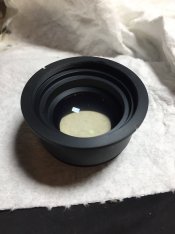mitchamtuell
Member
Yep, you read the title right: every lens repairer's worst nightmare.
I recently came into an RB67 for pretty cheap and took it on as a hobby repair project. Finally got around to cleaning out the moldy lens yesterday. Couldn't find a disassembly guide for exactly this lens, but there were some similar ones out there and I used my intuition and got it apart just fine. Cleaned the mildew from the front element, which is just a bare glass piece not in a mount, and the rear element, which appears to be also one piece of glass in a screw mount.
The middle element (is that what to call it?) appears to consist of two pieces of glass cemented into a mount. The pictures show it from the top and bottom. There is definitely yellow haze on the internal faces of the glass. I can't find anywhere online where people talk about how to actually get this apart - everyone just says "if there's haze on the inside you're screwed and should buy another lens". I don't accept that as an answer - I want to fix it!
Does anyone know how to do this? You can see in the picture where I tried to scrape off what appears to be shiny black lacquer so I could unscrew the back piece, which I'm guessing is how it comes apart. Also tried nail polish remover. If I do get it apart, will I be able to get it back together without special calibration tools?
I don't even have a film back for the camera yet so I can't do a test to see if the yellow haze actually affects the photo, but as you can see from the picture comparing it to the rear element, the yellow tint is clearly visible so I'm guessing it will at least throw off the colors, and it appears to be darkening as well.
Thanks for any help you can give me!



I recently came into an RB67 for pretty cheap and took it on as a hobby repair project. Finally got around to cleaning out the moldy lens yesterday. Couldn't find a disassembly guide for exactly this lens, but there were some similar ones out there and I used my intuition and got it apart just fine. Cleaned the mildew from the front element, which is just a bare glass piece not in a mount, and the rear element, which appears to be also one piece of glass in a screw mount.
The middle element (is that what to call it?) appears to consist of two pieces of glass cemented into a mount. The pictures show it from the top and bottom. There is definitely yellow haze on the internal faces of the glass. I can't find anywhere online where people talk about how to actually get this apart - everyone just says "if there's haze on the inside you're screwed and should buy another lens". I don't accept that as an answer - I want to fix it!
Does anyone know how to do this? You can see in the picture where I tried to scrape off what appears to be shiny black lacquer so I could unscrew the back piece, which I'm guessing is how it comes apart. Also tried nail polish remover. If I do get it apart, will I be able to get it back together without special calibration tools?
I don't even have a film back for the camera yet so I can't do a test to see if the yellow haze actually affects the photo, but as you can see from the picture comparing it to the rear element, the yellow tint is clearly visible so I'm guessing it will at least throw off the colors, and it appears to be darkening as well.
Thanks for any help you can give me!















